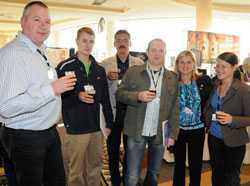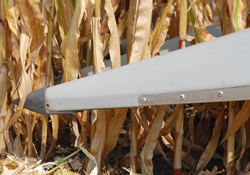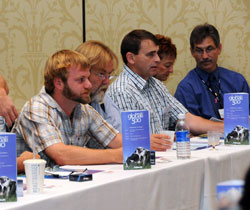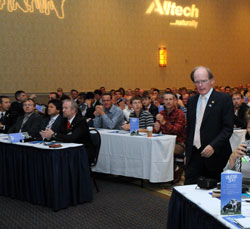 The Global Dairy 500 Conference is a truly international one. There are farmers here from all over the world which requires a lot of translators who are working very hard in their booths at the back of the conference presentation rooms.
The Global Dairy 500 Conference is a truly international one. There are farmers here from all over the world which requires a lot of translators who are working very hard in their booths at the back of the conference presentation rooms.
One of the groups I ran into early is from Germany. They were all enjoying an early sample of Bluegrass Sundown, a blend of bourbon, coffee and Irish Cream. It is fantastic btw. I had to sample as well.
 In the middle of this happy group is Henry. He spoke very good English so he got volunteered to speak with me. He has about 450 dairy cows and also row crops on his farm. He says he’s always on the search for new technology because it will make him more efficient. Henry echoes a comment I’ve heard a number of times today and that is that dairy farmers globally are suffering with the same problems, namely the price of milk.
In the middle of this happy group is Henry. He spoke very good English so he got volunteered to speak with me. He has about 450 dairy cows and also row crops on his farm. He says he’s always on the search for new technology because it will make him more efficient. Henry echoes a comment I’ve heard a number of times today and that is that dairy farmers globally are suffering with the same problems, namely the price of milk.
He says the economy is the biggest challenge facing him and getting better production. He says he spoke to a farmer from Ohio who has just moved out of the dairy business due to the economics. He is looking forward to talking with other farmers.
2009 Global Dairy 500 Conference Photo Album
You can listen to my interview with Henry below.
AgWired coverage of the Global Dairy 500 Conference is sponsored by  .
.



 USGC is encouraging all farmers to carry a camera in the combine this year to snap some photos of the harvesting of food, feed and fuel for the United States and abroad. Each photo will be entered for a free Council meeting registration for our 7th International Marketing Conference and 50th Annual Membership Meeting in Puerto Vallarta, Mexico, Feb. 13-17, 2010. Enter more than one photo to increase your chances of winning!
USGC is encouraging all farmers to carry a camera in the combine this year to snap some photos of the harvesting of food, feed and fuel for the United States and abroad. Each photo will be entered for a free Council meeting registration for our 7th International Marketing Conference and 50th Annual Membership Meeting in Puerto Vallarta, Mexico, Feb. 13-17, 2010. Enter more than one photo to increase your chances of winning! At an international conference like the Global Dairy 500 Conference translators are absolutely necessary. We have many of them here. During a break this morning I spoke with Irina Zablith (right) who is not only a translator but a veterinarian from Brazil. She’s translating into Portugese.
At an international conference like the Global Dairy 500 Conference translators are absolutely necessary. We have many of them here. During a break this morning I spoke with Irina Zablith (right) who is not only a translator but a veterinarian from Brazil. She’s translating into Portugese. You need go no further than any dairy farmer here at the Global Dairy 500 Conference to know that the big issue is money. Take Daniel Williams, seated to the left in the photo. Daniel has an 800 cow dairy in Madison, GA.
You need go no further than any dairy farmer here at the Global Dairy 500 Conference to know that the big issue is money. Take Daniel Williams, seated to the left in the photo. Daniel has an 800 cow dairy in Madison, GA. This is what the moon looked like tonight after a full day of the Global Dairy 500 Conference. This is a hand held shot on the way back from the Alltech Lexington Brewery.
This is what the moon looked like tonight after a full day of the Global Dairy 500 Conference. This is a hand held shot on the way back from the Alltech Lexington Brewery. More than 3,000 international scientists, professionals, educators, and students will present new technologies and discuss emerging trends in agriculture, energy, climate change, carbon trading, science education, and related issues at the event November 1-5 at the David L. Lawrence Convention Center. Other informative sessions will focus on nutrition, wines, food security, invasive species, organic agriculture, hazardous waste, plant breeding, and turfgrass science.
More than 3,000 international scientists, professionals, educators, and students will present new technologies and discuss emerging trends in agriculture, energy, climate change, carbon trading, science education, and related issues at the event November 1-5 at the David L. Lawrence Convention Center. Other informative sessions will focus on nutrition, wines, food security, invasive species, organic agriculture, hazardous waste, plant breeding, and turfgrass science. The Global Dairy 500 Conference is a truly international one. There are farmers here from all over the world which requires a lot of translators who are working very hard in their booths at the back of the conference presentation rooms.
The Global Dairy 500 Conference is a truly international one. There are farmers here from all over the world which requires a lot of translators who are working very hard in their booths at the back of the conference presentation rooms. In the middle of this happy group is Henry. He spoke very good English so he got volunteered to speak with me. He has about 450 dairy cows and also row crops on his farm. He says he’s always on the search for new technology because it will make him more efficient. Henry echoes a comment I’ve heard a number of times today and that is that dairy farmers globally are suffering with the same problems, namely the price of milk.
In the middle of this happy group is Henry. He spoke very good English so he got volunteered to speak with me. He has about 450 dairy cows and also row crops on his farm. He says he’s always on the search for new technology because it will make him more efficient. Henry echoes a comment I’ve heard a number of times today and that is that dairy farmers globally are suffering with the same problems, namely the price of milk.  Providing the first remarks on the program for the Global Dairy 500 Conference was Dr. Pearse Lyons, founder and President, Alltech. The theme of his opening remarks was to answer the question, “Is there a future for dairy in these turbulent times?”
Providing the first remarks on the program for the Global Dairy 500 Conference was Dr. Pearse Lyons, founder and President, Alltech. The theme of his opening remarks was to answer the question, “Is there a future for dairy in these turbulent times?” Looking to the future the key is efficiency and that will come about from the use of new technology. Besides efficiency he urged attendees to focus on more lactations per cow; quality in Production systems; more education; looking for Branding; traceability and to be conscious of the environment. I love his description of the dairy cow as a “walking fermenter.”
Looking to the future the key is efficiency and that will come about from the use of new technology. Besides efficiency he urged attendees to focus on more lactations per cow; quality in Production systems; more education; looking for Branding; traceability and to be conscious of the environment. I love his description of the dairy cow as a “walking fermenter.”